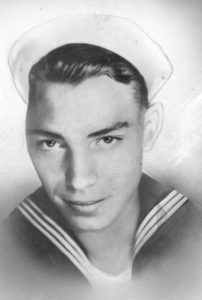WORLD WAR II VETERANS CONCORDIA PARISH LOUISIANA
U.S. NAVY Jesse W. Speed
SOUTHWEST PACIFIC
Fleet Tanker-AO49-Neosho Petty Officer 3rd Class Fire Controlman
Combat Experience- 7 Months in South Pacific, refueling Naval Vessels
I was born December 9, 1925, in Winnfield Louisiana. We moved to Ferriday in the fall of 1936. I went to Ferriday High and on November 17, 1942, I talked my Dad into signing for me to enter the Navy before the legal age of entry (17). I had never been outside the State of Louisiana in my life, but when I was sworn into the Navy that November, I was sent to San Diego, California for Boot Camp.
From Ferriday, we went by bus to Jackson, Mississippi, and from there. by train to San Diego. We arrived at about 11:00 PM and were immediately sent to the mess hall for chow. The first person I saw there was Marion Barnett from Ferriday. Marion had arrived a little earlier and was already on KP duty.
While in Boot Camp, I shared a barracks with Henry Fonda. He was treated just like the rest of the men. He was a nice guy who pulled his weight.
After Boot Camp, I went to Fire Controlman School. They taught me to aim and direct gunfire at incoming aircraft. We learned how to operate the gunsite and the electronics and gun directors that control the movement of anti-aircraft guns.
After graduation from that class, I was transferred to Pacific Beach, California (outside San Diego), and was promoted to Fire Controlman, Third Class. I was introduced to 20 mm, 40 mm and 5 inch 38 anti-aircraft guns, I would teach the men how to put the gunsite on the target sleeve that was being towed by an airplane and how to set the range into the gunsite to control the lead needed in order to hit the target.
After about two years as an instructor at Pacific Beach, I was transferred to sea duty aboard a fleet tanker (the AO 49 named Neosho) bound for the South Pacific to join the fleet that was in action against the Japanese Navy and land forces. We refueled the fleet which consisted of battleships, aircraft carriers, cruisers and destroyers. We were re-supplied with fuel by the Merchant Marine, who tried to stay a safe distance from the battle zone. None of us probably realized what a high priority target we were as a supply vessel.
On the way to the South Pacific, we had stopped off at Pearl Harbor, Hawaii and saw the ships that had been sunk December 7, 1941. From there we went to the South Pacific to the atoll islands which reach to the Philippines, while the army and marines were recapturing them from the Japanese.
My closest encounter to any action was during one of our re-fueling jobs near the atolls. We saw Japanese Kamikaze pilots fly over. We were instructed to put out smoke pots to look like fog covering the ship, so we would not be spotted. We were also instructed not to fire at the planes because they would follow the tracers and crash into our ships. In one of these encounters the plane was so low I could see its exhaust. In fact, one plane flew into a mast of one of our ships and crashed into the ocean.
After this, we operated with the fleet, about 50 miles off the coast of Japan, re-fueling the ships every morning so they could make night runs and shell the coast of Japan. This continued until the end of the war.
At the announcement of the war’s end, we were instructed to go into Tokyo Bay, We anchored about 1000 yards from the USS Missouri, where General Mac-Arthur signed the Peace Treaty with the surrendering General of the Japanese Army. I did get to go ashore and see some of the destruction we had caused the city and shipyards of Tokyo.
From Tokyo, we sailed back to San Francisco. I had shore patrol duty with no liberty our first and only night there. What a “Welcome Home” that was. We left the next day, going through the Panama Canal to Norfolk, Virginia, where the Neosho was decommissioned. I traveled by train to New Orleans where I was honorably discharged December 21, 1945. A bus ride returned me to Ferriday, where I have lived ever since.

Leave a Reply